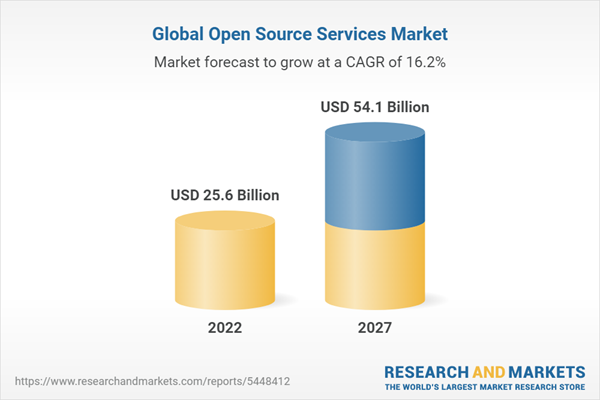The global OSS market is expected to grow from an estimated value of USD 25.6 billion in 2022 to USD 54.1 billion by 2027, at a Compound Annual Growth Rate (CAGR) of 16.2% from 2022 to 2027.
Increased action-oriented insights and the growing adoption of OSS due to the low ownership cost and offered agility, flexibility and dependability are driving market growth. However, limited capabilities to address the exploitation caused by malicious users and the associated hidden cost are expected to hinder market growth.
By service, professional services segment to account for larger market size during forecast period
Professional services are further categorized into three types: training and consulting services, support and maintenance, and implementation and integration. These services are primarily post-sales services that are delivered to customers after the purchase of the product. The customized, knowledge-based services offered to clients are considered within the ambit of professional services. Sometimes, new technology solutions must be merged with the existing legacy IT infrastructure so critical applications can be upgraded, and better ways can be implemented to manage and store data. Professional services include designing, planning, upgradation, and a host of consulting services offered to clients. Companies offering these services engage consultants, solutions experts, and dedicated project management teams specializing in designing and delivering critical decision-support solutions and services. The growth of the professional services segment is majorly governed by the complexity of operations and the increasing deployment of open source solutions for developing applications for advanced technologies, such as cloud services, AI, IoT, AI, and ML.
By professional services, implementation and integration segment to grow at highest CAGR during forecast period
Enterprise solutions are sophisticated and widely used. These applications are challenging to manage and maintain since every other organization has specific installation, module, feature, and packaging requirements. Open source integration can satisfy all efficiency and perfection standards. Open source software solutions need to be integrated with the existing systems; therefore, they require the right connectors and back-end integration capabilities. System integration services are gaining wide acceptance by end users globally, as these services ensure systems communicate with each other efficiently to enhance the appropriate working of the entire production process. System integration services begin with collecting the customers’ requirements and then deploying, integrating, testing, and rolling out solutions. System integration service providers help organizations develop a connected environment by integrating open source software with their existing IT infrastructure.
By organization size, large enterprises to account for major market size during forecast period
Organizations with more than 1,000 employees are categorized as large enterprises. Large enterprises were the early adopters of OSS as they have a huge workforce and associated networking devices, which could be integrated with the OSS platforms. Developers can use more open standards while using open-source software than they can with proprietary software from commercial vendors. Developers who have experience working on numerous challenging instances offer community support for open source technologies. On the open-source software's reusable modules, they offer insightful feedback.
Breakdown of Primaries
In-depth interviews were conducted with Chief Executive Officers (CEOs), marketing directors, other innovation and technology directors, and executives from various key organizations operating in the OSS market.
- By company type: Tier 1 - 35%, Tier 2 - 45%, and Tier 3 - 20%
- By designation: C-level - 40% and Managerial and other levels - 60%
- By region: North America - 20%, Asia Pacific - 45%, and Europe - 35%
Major vendors in the global OSS market include IBM (US), Accenture (Ireland), Mulesoft (US), Wipro (India), Databricks (US), Suse (Germany), Cisco (US), Percona (US), Infosys (India), HPE (US), HCL Infosystems (India), Happiest Minds Technologies (India), Quansight (US), Swan Solutions & Services (India), Nous Infosystems (India), Charter Global (US), ViSolve (US), Chetu (US), Evoke Technologies (US), HashiCorp (US), Confluent (US), C Ahead Technologies (US), Puppet (US), Eclature Technologies (UK), Tidelift (US) and Collabora (UK).
The study includes an in-depth competitive analysis of the key players in the OSS market, with their company profiles, recent developments, and key market strategies.
Research Coverage
The report segments the OSS market and forecasts its size by service type, professional services, organization size, vertical, and region.
Key Benefits of Buying the Report
The report will help market leaders/new entrants in this market with information on the closest approximations of the revenue numbers for the overall OSS market and its subsegments. It will help stakeholders understand the competitive landscape and gain more insights to position their businesses better and plan suitable go-to-market strategies. It also helps stakeholders understand the pulse of the market and provides them with information on key market drivers, restraints, challenges, and opportunities.
Table of Contents
Companies Mentioned
- Ibm
- Suse
- Mulesoft
- Wipro
- Accenture
- Cisco Systems
- Infosys
- Percona
- Hpe
- Hcl
- Happiest Minds
- Quansight
- Swan Solutions & Services
- Nous Infosystems
- Charter Global
- Visolve
- Chetu
- Evoke Technologies
- C Ahead
- Collabora
- Puppet
- Hashicorp
- Databricks
- Eclature
- Confluent
- Tidelift
Table Information
| Report Attribute | Details |
|---|---|
| No. of Pages | 235 |
| Published | December 2022 |
| Forecast Period | 2022 - 2027 |
| Estimated Market Value ( USD | $ 25.6 Billion |
| Forecasted Market Value ( USD | $ 54.1 Billion |
| Compound Annual Growth Rate | 16.2% |
| Regions Covered | Global |
| No. of Companies Mentioned | 26 |









